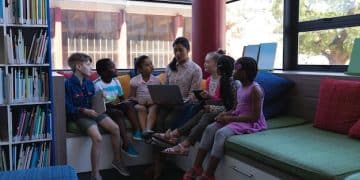Maximize Retention: A 2025 Guide to Combining Learning Styles

How to Combine Learning Styles for Maximum Retention: A Comprehensive Guide for 2025 explores how understanding and integrating different learning styles can significantly enhance knowledge retention, offering practical strategies for educators and learners to optimize the learning process.
Unlock your full learning potential by understanding how to combine different learning styles for maximum retention. This comprehensive guide for 2025 will provide you with actionable strategies to optimize your learning experience.
Understanding Learning Styles: A 2025 Perspective
In 2025, understanding learning styles remains a cornerstone of effective education. Recognizing how individuals process information can lead to more personalized and impactful learning experiences. This section explores the core learning styles and their relevance in today’s educational landscape.
The VARK Model: A Foundation
The VARK model, which includes Visual, Auditory, Read/Write, and Kinesthetic learning styles, provides a fundamental framework for understanding different learning preferences. Each style caters to a unique way of processing information, influencing how learners best absorb and retain knowledge.
- Visual Learners: These individuals learn best through visual aids, such as diagrams, charts, and videos.
- Auditory Learners: They prefer listening to lectures, discussions, and audio recordings to grasp new concepts.
- Read/Write Learners: These learners excel when reading and writing information, benefiting from textbooks, notes, and written assignments.
- Kinesthetic Learners: Hands-on activities, experiments, and real-world applications are most effective for kinesthetic learners.
By recognizing these distinct preferences, educators can tailor their teaching methods to accommodate a wider range of learners, enhancing engagement and retention.
Learning styles are not fixed; individuals often exhibit a blend of preferences. The key is to identify the dominant tendencies and incorporate strategies that cater to these strengths. In a 2025 educational context, this personalized approach is more crucial than ever.
Why Combining Learning Styles is Essential for Retention
Combining learning styles is not just about catering to individual preferences; it’s a strategic approach to boosting memory and understanding. When multiple senses and cognitive processes are engaged, the brain forms stronger neural connections, leading to better retention. This section explores why integrating various learning styles is vital for maximizing knowledge retention.
Enhanced Cognitive Engagement
Engaging multiple learning styles stimulates different areas of the brain, fostering a more comprehensive understanding of the subject matter. For example, a visual learner might benefit from seeing a diagram, while a kinesthetic learner might better grasp the concept by building a model.

- Improved Memory: Multi-sensory experiences create richer memory traces, making information easier to recall.
- Deeper Understanding: Different learning styles offer unique perspectives, leading to a more nuanced comprehension.
- Increased Motivation: Tailoring learning to individual preferences can boost engagement and enthusiasm.
A well-rounded approach, incorporating visual, auditory, read/write, and kinesthetic elements, ensures that learners can access information in a way that resonates with them, leading to improved memory and understanding.
Combining learning styles is not about diluting the approach but about amplifying the learning experience. It’s about creating a richer, more engaging environment that accommodates a variety of learners and promotes deeper retention.
Practical Strategies for Integrating VARK in 2025
Integrating the VARK model into your learning strategy can seem daunting, but with a few practical strategies, it can be seamlessly incorporated into both teaching and self-study. This section provides actionable methods for effectively combining visual, auditory, read/write, and kinesthetic learning styles in 2025.
Creating Multi-Sensory Learning Materials
One of the most effective ways to integrate VARK is by creating learning materials that cater to multiple senses. This could involve using videos with visual aids and narration, or combining written notes with hands-on activities.
- Visual Integration: Incorporate diagrams, charts, and infographics into your study materials.
- Auditory Enhancement: Record lectures or create audio summaries of key concepts.
- Read/Write Practice: Take detailed notes and write summaries of what you’ve learned.
- Kinesthetic Application: Engage in hands-on activities, experiments, or real-world scenarios to apply the concepts.
By incorporating these strategies, learners can tap into their preferred learning styles while also strengthening their understanding through different modalities.
Effective integration requires thoughtful planning. It’s about finding the right balance and using the most appropriate methods for the subject matter at hand. The goal is to create a comprehensive learning experience that maximizes engagement and retention.
Technology’s Role in Supporting Combined Learning Styles
In 2025, technology plays a pivotal role in facilitating the integration of various learning styles. Digital tools and platforms offer unprecedented opportunities to personalize and diversify the learning experience. This section explores how technology can support the combined learning styles approach.
Digital Tools for VARK Integration
Numerous digital tools are available to support each learning style. From video conferencing to interactive simulations, technology can help cater to diverse learning preferences and enhance retention.

- Video Conferencing: Platforms like Zoom and Microsoft Teams support auditory learners through lectures and discussions.
- Interactive Simulations: Tools like PhET and Unity offer hands-on experiences for kinesthetic learners.
- E-Books and Note-Taking Apps: Applications likeEvernote and OneNote cater to read/write learners.
- Visual Design Tools: Software like Canva and Adobe Creative Suite support visual learners through graphic design and presentations.
Technology can personalize the learning experience, making it more engaging and effective for each individual. By leveraging these tools thoughtfully, educators and learners can create a dynamic learning environment.
Technology enables a new era of personalized education, where learning styles are not just acknowledged but actively supported. By embracing these digital tools, we can create a more inclusive and effective learning environment for all.
Overcoming Challenges in Implementing Combined Learning
While combining learning styles offers numerous benefits, it’s not without its challenges. From time constraints to resource limitations, educators and learners may face obstacles in implementing a comprehensive, multi-faceted approach. This section addresses common challenges and provides strategies for overcoming them.
Time and Resource Constraints
One of the primary challenges is the time required to create and implement diverse learning materials. Educators may struggle to find the time and resources needed to cater to each learning style individually.
Start with small changes. Instead of revamping your entire curriculum, focus on incorporating small, manageable elements that cater to different learning styles. For example, add visual aids to your lectures or provide opportunities for hands-on activities. Collaboration with colleagues can also help to share the workload and pool resources.
Combining learning styles is an ongoing process, and it’s important to be flexible and adaptive. By addressing these challenges head-on and implementing thoughtful solutions, educators and learners can create a more enriching and effective learning experience.
Assessing the Impact of Combined Learning Strategies
Measuring the effectiveness of combined learning strategies is crucial for understanding their impact on retention and comprehension. By using a combination of quantitative and qualitative assessment methods, educators and learners can gain insights into what works best and adjust their approach accordingly. This section explores how to evaluate the success of integrated learning techniques.
Quantitative and Qualitative Assessment
Quantitative assessments, such as tests and quizzes, provide measurable data on knowledge retention. Qualitative assessments, such as surveys and feedback sessions, offer insights into the learning experience and how well the strategies resonate with learners.
- Tests and Quizzes: Measure knowledge retention and comprehension.
- Surveys and Questionnaires: Gather feedback on learning preferences and satisfaction.
- Observation: Observe learners during activities and note their engagement and participation.
- Feedback Sessions: Conduct discussions to gather in-depth insights into the learning experience.
By using a variety of methods, educators and learners can gain a comprehensive understanding of the effectiveness of their combined learning strategies. This data-driven approach ensures that learning is constantly refined and optimized for better outcomes.
| Key Element | Brief Description |
|---|---|
| 🧠 VARK Model | Identifies Visual, Auditory, Read/Write, and Kinesthetic learning styles. |
| 🔗 Cognitive Engagement | Enhances memory and understanding by engaging multiple senses. |
| 💻 Tech Integration | Leverages digital tools for personalized learning experiences. |
| 📈 Assessment | Uses quantitative and qualitative methods to measure effectiveness. |
Frequently Asked Questions
▼
The VARK model identifies four primary learning styles: Visual, Auditory, Read/Write, and Kinesthetic. Each style represents a different way individuals prefer to process and retain information.
▼
Combining learning styles enhances cognitive engagement, improves memory, and leads to a deeper understanding of the subject matter. It also caters to a wider range of learners.
▼
Technology offers digital tools like video conferencing, interactive simulations, and e-books, enabling personalized learning experiences and supporting diverse learning preferences.
▼
Common challenges include time constraints, resource limitations, and the need for thorough planning. Starting with small, manageable changes can help overcome these obstacles.
▼
Use a combination of quantitative assessments like tests and qualitative assessments like surveys and feedback sessions to gain insights into the impact on retention and comprehension.
Conclusion
Integrating different learning styles is a powerful approach to enhancing knowledge retention and improving learning outcomes. By understanding and implementing strategies that cater to visual, auditory, read/write, and kinesthetic preferences, educators and learners can create a more engaging and effective learning environment.





